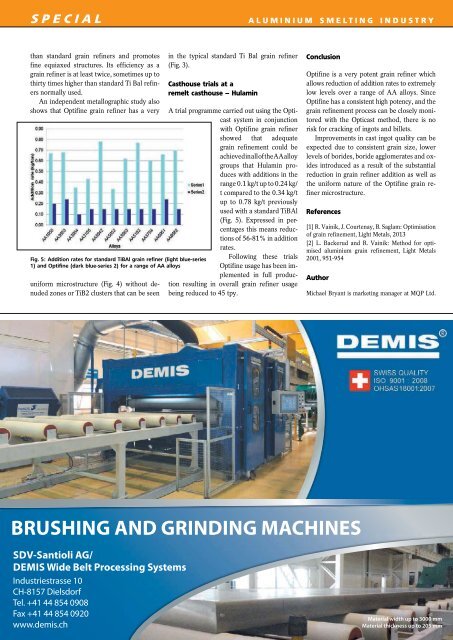special - Alu-web.de
special - Alu-web.de
special - Alu-web.de
You also want an ePaper? Increase the reach of your titles
YUMPU automatically turns print PDFs into web optimized ePapers that Google loves.
SPECIAL<br />
ALUMINIUM SMELTING INDUSTRY<br />
than standard grain refiners and promotes<br />
fine equiaxed structures. Its efficiency as a<br />
grain refiner is at least twice, sometimes up to<br />
thirty times higher than standard Ti Bal refiners<br />
normally used.<br />
An in<strong>de</strong>pen<strong>de</strong>nt metallographic study also<br />
shows that Optifine grain refiner has a very<br />
Fig. 5: Addition rates for standard TiBAl grain refiner (light blue-series<br />
1) and Optifine (dark blue-series 2) for a range of AA alloys<br />
uniform microstructure (Fig. 4) without <strong>de</strong>nu<strong>de</strong>d<br />
zones or TiB2 clusters that can be seen<br />
in the typical standard Ti Bal grain refiner<br />
(Fig. 3).<br />
Casthouse trials at a<br />
remelt casthouse – Hulamin<br />
A trial programme carried out using the Opticast<br />
system in conjunction<br />
with Optifine grain refiner<br />
showed that a<strong>de</strong>quate<br />
grain refinement could be<br />
achieved in all of the AA alloy<br />
groups that Hulamin produces<br />
with additions in the<br />
range 0.1 kg/t up to 0.24 kg/<br />
t compared to the 0.34 kg/t<br />
up to 0.78 kg/t previously<br />
used with a standard TiBAl<br />
(Fig. 5). Expressed in percentages<br />
this means reductions<br />
of 56-81% in addition<br />
rates.<br />
Following these trials<br />
Optifine usage has been implemented<br />
in full production<br />
resulting in overall grain refiner usage<br />
being reduced to 45 tpy.<br />
Conclusion<br />
Optifine is a very potent grain refiner which<br />
allows reduction of addition rates to extremely<br />
low levels over a range of AA alloys. Since<br />
Optifine has a consistent high potency, and the<br />
grain refinement process can be closely monitored<br />
with the Opticast method, there is no<br />
risk for cracking of ingots and billets.<br />
Improvements in cast ingot quality can be<br />
expected due to consistent grain size, lower<br />
levels of bori<strong>de</strong>s, bori<strong>de</strong> agglomerates and oxi<strong>de</strong>s<br />
introduced as a result of the substantial<br />
reduction in grain refiner addition as well as<br />
the uniform nature of the Optifine grain refiner<br />
microstructure.<br />
References<br />
[1] R. Vainik, J. Courtenay, B. Saglam: Optimisation<br />
of grain refinement, Light Metals, 2013<br />
[2] L. Backerud and R. Vainik: Method for optimised<br />
aluminium grain refinement, Light Metals<br />
2001, 951-954<br />
Author<br />
Michael Bryant is marketing manager at MQP Ltd.<br />
BRUSHING AND GRINDING MACHINES<br />
SDV-Santioli AG/<br />
DEMIS Wi<strong>de</strong> Belt Processing Systems<br />
Industriestrasse 10<br />
CH-8157 Dielsdorf<br />
Tel. +41 44 854 0908<br />
Fax +41 44 854 0920<br />
www.<strong>de</strong>mis.ch<br />
Material width up to 3000 mm<br />
Material thickness up to 205 mm
















